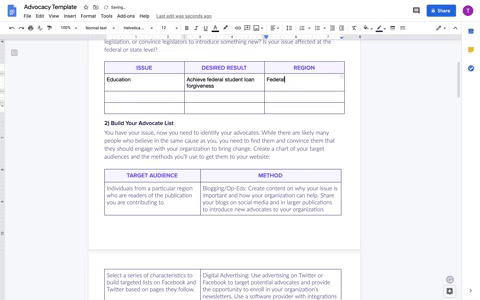1) Define Your Issue
What issues does your organization care about? Are you trying to change an existing piece of legislation, or convince legislators to introduce something new? Is your issue affected at the federal or state level?
2) Build Your Advocate List
You have your issue, now you need to identify your advocates. While there are likely many people who believe in the same cause as you, you need to find them and convince them that they should engage with your organization to bring change. Create a chart of your target audiences and the methods you’ll use to get them to your website.
3) Educate Advocates on How to Engage Their Legislators
Engaging with elected officials can be nerve-wracking or confusing if advocates have never reached out to their representatives. Your organization should provide resources to educate advocates on how to accomplish key tasks.
Best Practice: Set up a series of emails to share resources for each step of the advocacy process, then track who opens and engages with your emails. If an advocate has opened and clicked on an email, you can send them a second email with resources on the next step in the process. If a period of time has passed and they have not opened or engaged with your email, resend the email with additional information on why it is important. See how the American Society of Anesthesiologists does this with Quorum’s integrated email tool, Outbox. For a deeper explanation of how ASA educates their advocates, watch this webinar.
4) Set Benchmarks to Identify Grasstops Advocates
Grasstops advocates are key to your organization’s advocacy plan as they will be the most active in your campaign. Grasstops advocates can be identified in two main ways. First, you can survey existing advocates to find those with the qualities your organization looks for in a grasstops advocate. Second, you can provide an opportunity for grassroots advocates to enroll in a training program your organization runs to elevate their level of contribution. In order to organize a survey and training program, outline the qualities that would distinguish a grassroots advocate, an individual who is a candidate for grasstops training, and an existing grasstops advocate.
5) Host a Lobby Day
Whether your organization is advocating for change at the state or federal level, bringing your advocates to the state house or the Capitol building can be an effective way to show the size and volume of your organization’s voice. To have a successful lobby day, it’s critical to make sure that advocates are prepared with statements to provide to staffers and materials to leave with an office after a meeting.
To learn from your lobby day meetings, have your advocates take meeting notes on what they discussed and what the takeaways were from the conversation. Consider Quorum’s interaction logger to provide a digital tool to advocates to log their conversations with staffers and legislators.
6) Plan How to Activate Advocates in a “Code Red” Event
As news breaks or votes happen, you may need to quickly call your advocates to action to contact their legislators. Perhaps you just learned a key vote is happening the next day or a member made a statement that you want advocates to react to. Make sure you have a plan ready to launch an advocacy campaign at the drop of a hat if necessary.
Best Practice:
The key to grassroots advocacy is to be prepared—make sure your advocates are prepared when its time for them to reach out to their legislators and that you are prepared when its necessary to organize and launch a campaign. Volume alone isn’t always enough to bring change on an issue, but using your advocates’ time and efforts effectively can help break through the noise.



